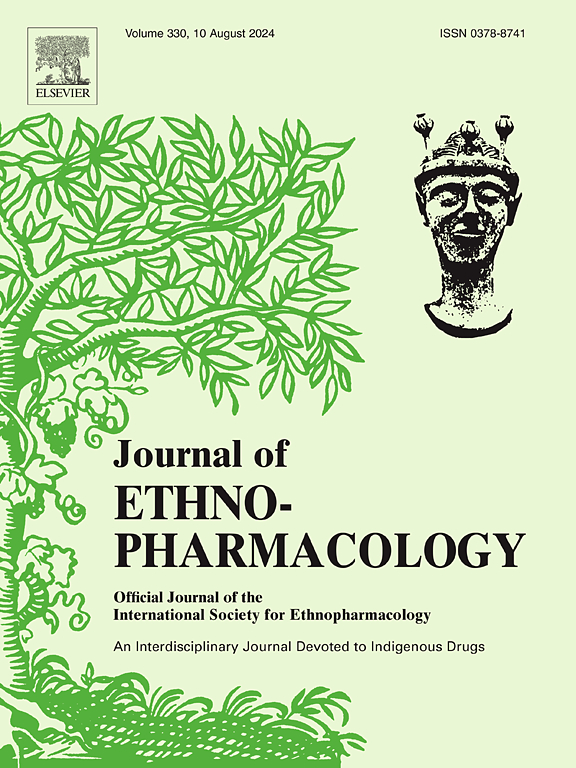Astragalus membranaceus-Carthamus tinctorius herb pair antagonizes parthanatos in cerebral ischemia/reperfusion injury via regulating PARP-1/TAX1BP1-mediated mitochondrial respiratory chain complex I
IF 4.8
2区 医学
Q1 CHEMISTRY, MEDICINAL
引用次数: 0
Abstract
Ethnopharmacological relevance
The combination of Astragalus membranaceus (Huang Qi in Chinese, HQ) and Carthamus tinctorius (Hong Hua in Chinese, HH) is commonly employed for treating ischemic stroke (IS). The heavily oxidative environment of cerebral ischemia/reperfusion injury (CI/RI) promotes activation of poly (ADP-ribose) polymerase-1 (PARP-1), which initiates parthanatos, a regulated cell death mode. Reactive oxygen species (ROS) bursting in mitochondrial respiratory chain complex I (Complex I) is a key cause of CI/RI. Nevertheless, the intrinsic mechanism of its involvement in Complex I in the parthanatos cascade remains obscure.
Aim of the study
This experiment aimed to investigate that HQ-HH antagonized parthanatos via regulating PARP-1/TAX1BP1-mediated Complex I to attenuate CI/RI.
Materials and methods
The HPLC fingerprint of HQ-HH was established, and the contents of 9 components were determined. The neuroprotective effect of HQ-HH in CI/RI was evaluated by rat middle cerebral artery occlusion/reperfusion (MCAO/R) and BV2 cell oxygen glucose deprivation/reoxygenation (OGD/R) models. Pathological changes in brain tissue of MCAO/R rats were observed using TTC staining, HE staining, and TEM. Complex I activity was measured in MCAO/R rats and OGD/R-treated BV2 cells. qRT-PCR and Western blot were performed to detect the expressions of related genes and proteins of parthanatos and Complex I as well as tax1 binding protein 1 (TAX1BP1). Immunofluorescence staining was employed to certify the nuclear translocation of apoptosis-inducing factor (AIF) in MCAO/R rats.
Results
The HPLC fingerprint of HQ-HH with 25 common peaks and the contents of 9 components were obtained. HQ-HH improved behavioral function and alleviated cerebral infarction in MCAO/R rats in a dose-dependent manner. HQ-HH alleviated parthanatos and exhibited the same repressive effect on PARP-1 transcription and translation as PJ34 (PARP-1 inhibitor). Moreover, the migration of TAX1BP1 to the mitochondria was restrained with HQ-HH treatment as a downstream of PARP-1, resulting in the inhibition of Complex I activity and less ROS production, accompanied by a decrease in mRNA and protein levels of ND1 and ND2. Subsequently, the nuclear translocation of AIF and the generation of poly(ADP-ribose) (PAR) polymers were suppressed.
Conclusions
HQ-HH mitigated CI/RI by regulating PARP-1/TAX1BP1 to inhibit the Complex I activity with less ROS production, further impeding nuclear translocation of AIF, and ultimately antagonizing parthanatos. By emphasizing the link between parthanatos and Complex I, we anticipate providing new empirical evidence for HQ-HH therapy of IS.

黄芪-红花对通过调节PARP-1/ tax1bp1介导的线粒体呼吸链复合体I拮抗脑缺血再灌注损伤中的parthanatos。
民族药理学相关性:黄芪(Astragalus aceus, HQ)与红花(Carthamus tinctorius, HH)联合用药是治疗缺血性脑卒中(缺血性脑卒中)的常用药物。脑缺血/再灌注损伤(CI/RI)的重度氧化环境促进了聚(adp -核糖)聚合酶-1 (PARP-1)的激活,从而启动parthanatos,这是一种受调节的细胞死亡模式。线粒体呼吸链复合体I (complex I)中活性氧(ROS)的爆发是导致CI/RI的重要原因。然而,其参与parthanatos级联的复合体I的内在机制仍然不清楚。研究目的:本实验旨在探讨HQ-HH通过调节PARP-1/ tax1bp1介导的复合体I来减弱CI/RI,从而拮抗parthanatos。材料与方法:建立HPLC指纹图谱,测定9种成分的含量。采用大鼠大脑中动脉闭塞/再灌注(MCAO/R)和BV2细胞氧葡萄糖剥夺/再氧合(OGD/R)模型评价hh - hh对CI/RI的神经保护作用。采用TTC染色、HE染色、TEM观察MCAO/R大鼠脑组织病理变化。在MCAO/R大鼠和OGD/R处理的BV2细胞中测定复合物I的活性。采用qRT-PCR和Western blot检测parthanatos及其复合体I相关基因和蛋白以及tax1结合蛋白1 (TAX1BP1)的表达情况。采用免疫荧光染色法证实MCAO/R大鼠中凋亡诱导因子(AIF)的核易位。结果:获得了HPLC指纹图谱,共有25个峰,9种成分的含量。HQ-HH改善MCAO/R大鼠行为功能,减轻脑梗死,呈剂量依赖性。HQ-HH对PARP-1的转录和翻译具有与PJ34 (PARP-1抑制剂)相同的抑制作用。此外,作为PARP-1的下游,HQ-HH处理抑制了TAX1BP1向线粒体的迁移,导致复合物I活性受到抑制,ROS产生减少,同时ND1和ND2的mRNA和蛋白水平降低。随后,AIF的核易位和聚(adp -核糖)(PAR)聚合物的产生被抑制。结论:HQ-HH通过调节PARP-1/ TAX1BP1抑制复合物I活性,减少ROS的产生,进一步阻碍AIF的核易位,最终拮抗parthanatos,从而减轻CI/RI。通过强调parthanatos与Complex I之间的联系,我们期望为HQ-HH治疗IS提供新的经验证据。
本文章由计算机程序翻译,如有差异,请以英文原文为准。
求助全文
约1分钟内获得全文
求助全文
来源期刊

Journal of ethnopharmacology
医学-全科医学与补充医学
CiteScore
10.30
自引率
5.60%
发文量
967
审稿时长
77 days
期刊介绍:
The Journal of Ethnopharmacology is dedicated to the exchange of information and understandings about people''s use of plants, fungi, animals, microorganisms and minerals and their biological and pharmacological effects based on the principles established through international conventions. Early people confronted with illness and disease, discovered a wealth of useful therapeutic agents in the plant and animal kingdoms. The empirical knowledge of these medicinal substances and their toxic potential was passed on by oral tradition and sometimes recorded in herbals and other texts on materia medica. Many valuable drugs of today (e.g., atropine, ephedrine, tubocurarine, digoxin, reserpine) came into use through the study of indigenous remedies. Chemists continue to use plant-derived drugs (e.g., morphine, taxol, physostigmine, quinidine, emetine) as prototypes in their attempts to develop more effective and less toxic medicinals.
 求助内容:
求助内容: 应助结果提醒方式:
应助结果提醒方式:


